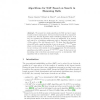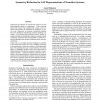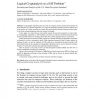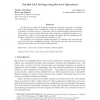58 search results - page 8 / 12 » Redundancy in Random SAT Formulas |
STACS
2004
Springer
14 years 21 days ago
2004
Springer
We present two simple algorithms for SAT and prove upper bounds on their running time. Given a Boolean formula F in conjunctive normal form, the first algorithm finds a satisfyin...
AIPS
2003
13 years 8 months ago
2003
Symmetries are inherent in systems that consist of several interchangeable objects or components. When reasoning about such systems, big computational savings can be obtained if t...
JAR
2000
13 years 7 months ago
2000
Cryptographic algorithms play a key role in computer security and the formal analysis of their robustness is of utmost importance. Yet, logic and automated reasoning tools are seld...
JACM
2007
13 years 7 months ago
2007
This article provides a new conceptual perspective on survey propagation, which is an iterative algorithm recently introduced by the statistical physics community that is very effe...
JSAT
2008
13 years 7 months ago
2008
We show how to exploit the 32/64 bit architecture of modern computers to accelerate some of the algorithms used in satisfiability solving by modifying assignments to variables in ...




